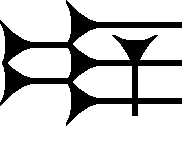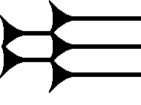
The cuneiform sign for tur is used to denote one syllabic usage, tur, or the sign's Sumerograms; it is used in the Epic of Gilgamesh and the 14th century BC Amarna letters. The sign is based on the i (cuneiform) sign, with the one small added vertical stroke.
Besides tur, it is for Sumerograms (logograms) BÀN, DUMU, and TUR. In the Epic of Gilgamesh, it is used in the following numbers: tur-(11 times), BÀN-(3), DUMU-(25), TUR-(2).[1] The large usage of DUMU in the Epic is for the Sumerogram being the equivalent of "son", Akkadian language "māru".[2]
YouTube Encyclopedic
-
1/3Views:80 7419814 426
-
ISIS versus Cuneiform - the linguistics behind the news
-
Aramean history-10
-
Rolling Stones: Looking at Ancient Mesopotamian Cylinder Seals
Transcription
In Mesopotamia, this is happening. The destruction of ancient treasures, even the leveling of entire cities, by the self-named dawlah al-islamiyah. I think the reason this hurts us so much has something to do with language. We have much older artifacts. We even know of older cities. But the people of Mesopotamia were the first to speak to us on their terms in their own words. Whose words? For starters, Sumer. 5500 years ago, they spoke and wrote in emegir, Sumerian, an isolate unrelated to surrounding languages. Even when the Akkadians took over 1200 years later, they kept Sumerian civilization going, Sumerianizing their words and culture - as one linguist puts it - “on a massive scale”. This amazingly early cultural transmission shaped ideas in the Middle East and Europe. At a time when most languages have to be hypothesized, we know what the Mesopotamians had to say. Here. This is a city. They called it Eridu. This is how much barley every child and every adult should get: 20 pints for the kids, 30 to 40 for the grown ups. This is a story they wrote about a giant flood. The first documented Semitic language wasn’t written in Phoenician or the Hebrew alphabet. It was in Cuneiform. Even the oldest Indo-European texts were written in Cuneiform. Now, I think, contrary to what’s going around on the news, Cuneiform doesn’t make Mesopotamia EVERYONE’S cradle of civilization. It’s hard to see what kind of impact Sumer could have had on China, and certainly the Caral and the Olmec in the Americas were a world away. But it was this act of writing early and extending its influence to later ages that causes us to connect with Cuneiform civilizations, to hold them in such high regard, and to stand horrified at people who, confronted with that same influence, feel not respect, but hate.
Amarna letter usage
In the Amarna letters, the topic of Amarna letter EA 296, Under the Yoke, is the guarding of two cities, at the city gate; also the man authoring the letter, Yabitiri-(Yahtiru)-(governor?) of City? gives his history of going to Egypt to be trained with the Pharaoh, EA 296, line 25 (tablet reverse): "... (25) "i-nu-ma TUR a-na-ku", (26) he (Yanhamu) took me to (Egypt) Misri (27)..., (25) "Now when "YOUNG"-(I, myself), (26) he (i.e. Yanhamu) took me to Egypt, (27) ..."[3]
Common text usage
The most common text usage is unlike the digital version. It is composed of 5-horizontals: one (single) above two pairs of two, and all sitting on a large single horizontal stroke, approximated as follows:
It is found in various Amarna letters as part of "Messenger-Xxxxx", for example "LÚ.PA.TUR-Uv-wx-yz"
References
- ^ Parpola, 1971. The Standard Babylonian Epic of Gilgamesh, Sign List, pp. 155-165, no. 144, p. 158.
- ^ Parpola, 1971. The Standard Babylonian Epic of Gilgamesh, Glossary, pp. 119-145, māru, p. 131-132.
- ^ Rainey, 1970. El Amarna Tablets, 359-379, Glossary:Vocabulary, pp. 55-95, sehru-(no. 2)-(small), p. 79; Indexes: II. Sumerograms, TUR, p. 98-99.
- Moran, William L. 1987, 1992. The Amarna Letters. Johns Hopkins University Press, 1987, 1992. 393 pages.(softcover, ISBN 0-8018-6715-0)
- Parpola, 1971. The Standard Babylonian Epic of Gilgamesh, Parpola, Simo, Neo-Assyrian Text Corpus Project, c 1997, Tablet I thru Tablet XII, Index of Names, Sign List, and Glossary-(pp. 119–145), 165 pages.
|
|

